| Works of Annie Fields |
by
Annie Fields
1896
Part 5 -- February 5 - 9
Haiti
[ Wednesday 5 February]
Wed. Feb. 5th A lovely day -- at nine o-clock we
are to steam away for San Domingo and the far South.* The
Coolies continue to interest us everywhere. On the road to
Mandeville, were saw one poor woman who was threatened by
a colored brute who had a hammer. Her young daughter
disarmed him. She said -- "I will not let her marry a
nigger"! She was in great distress. It was the only
overt expression of ^the^ dislike which ^[really ?]^
exists that we have seen -- but that was enough.
Note
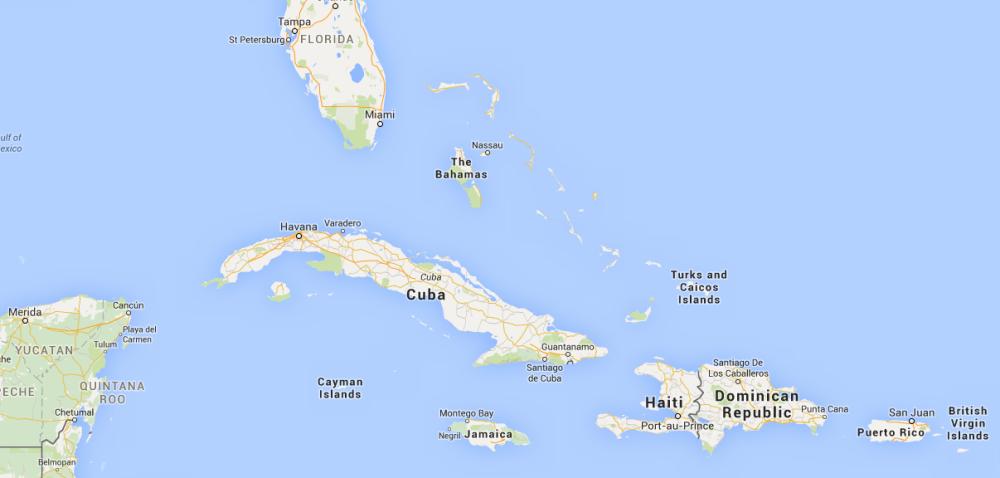
Map of the area of the Hermione's cruise
Courtesy of Google Maps
Thurs. Feb. 6th Port Morant or Morant
Bay.* We came in here about two o'clock. We had been
butting the trade-winds all the way and almost everybody was
sick. Unhappily ----------
Thurs. Feb. 6th Steamed to Port Morant -- a favoring
wind had been most lovely on our way here, but now the trade
winds were against us and the sea was rough. Whereupon our
poor "lord-high-admiral" Lilian Aldrich was sea-sick{.}* we came
to anchor where it was hot and purposeless until ^X X X^* when
we started in the afternoon again for San Domingo --
unluckily the night was very stormy -- everyone was
sea-sick T.B.A.
Page 64
reduced to the last point of misery and
Friday 7th we came to anchor off Haiti. Here a council was called{,} Lilian wishing to be carried home. Mr. Pierce suffering keen disappointment because of his plans overturned. S.O.J. although sick still "game"! and wishing to go on. I asked from my berth in the morning of [two deleted words] Bridget who waits on us "How long before we reach San Domingo Bridget?"* {"}O we're not going, {"}she said, with a cheerful air, {"}we've turned round and are going home"! Then my desire to do anything quite deserted me! How dreary it seemed to make any effort if we were not going after all to see these interesting islands. By and by, I crept up and found disappointment everywhere. Mr. Pierce does not know what to do. As the day went on however he decided that if the sea was smooth we could take a northern passage perhaps to St. Thomas.* We made a brief anchorage in the afternoon where we were not allowed to stay much to the Commander's joy as we discovered afterward and this morning Saturday Feb. 8th finds us north [north is written over something] of Haiti in delightful seaway cruising quickly along. L. A. however refuses to be comforted. She wishes to return and I fear we shall not be able to prevail against this idea -- I am reading Stevenson's letters from Vailima* with delight. The sea is perfectly beautiful with forest clad mountains sloping down directly into it on one side on the other the cool air from the north
Page 65
and the open sea -- nothing could be more relaxing.
Notes
Morant Bay: Morant Bay is on the southeast coast
of Jamaica, less than 40 miles from Kingston.
"lord-high-admiral": Giving this title to Lilian
Aldrich only on this page of the journal raises complex
questions about Fields's tone. It seems likely that the
February 6-8 entries were written at the same time, probably on
February 8. If this is correct, then Fields gives Lilian
the title in the knowledge that this bout of sea-sickness will
become so extreme as to break Lilian, so that she demands that
they return to the continent immediately. The title is
then almost certainly ironic, pointing to Lilian's usurpation of
command of the cruise. On the other hand, it is possible
that Lilian, like T. B. A., (the Commodore) was regularly given
a naval title, by this generally good-humored and high-spirited
group, with its long history of using nicknames for their
intimate friends.
In a letter of 28 March 1896, Fields probably
seeks to mend a stressed relationship when she writes to the
Aldriches:
I am sending back the little trunk with a heartfelt thanks not only for this but for all you have both done to make us happy during the Cruise -- "Everybody loves you", or could would and should who shared the fortunes of the "Hermione."
Fields goes on to note that Jewett remains quite ill after the
cruise, a reason why it was a good idea to curtail the trip
despite everyone's disappointment. In Sarah Orne
Jewett, Paula Blanchard reports that Jewett lost nearly 10
pounds during their weeks at sea (p. 301).
Jewett, on the other hand, seemed to find it
easier to reflect upon the cruise's hardships with good
humor. On 9 April 1896, she wrote to Thomas Wentworth
Higginson:
I am truly sorry that you have had such a siege of illness, and I hope that the month since you wrote your letter has done much for you. I think it may seem unsympathetic to suggest that my own diet in the regions of the Caribbean sea on the other side of the republic of Haiti and in the Navassa passage makes yours of the winter sound like a banquet! Trade winds taken the wrong way can make a monstrous sea: but when half a dozen of the crew are in the last agonies no wonder that a reflective passenger goes below and reads the letters of Madame de Sévigné and declines a summons to luncheon.
XXX: Fields appears to have tried proper nouns
here, both beginning with H. She deleted the first and
inserted the second, then deleted the second. Her final
decision was to insert XXX.
Bridget: In addition to the Hermione crew,
the passengers included the owner, Henry Pierce, his friends
Thomas Bailey Aldrich and his wife, Lilian, their Irish-born
servant, Bridget, and Aldrich friends, Annie Fields and Sarah
Orne Jewett. Further information about Bridget is welcome.
St. Thomas: St. Thomas in the United States Virgin
Islands is almost due east of Jamaica. Presumably by a
"northern passage," Pierce means to sail along the northern
coasts of Haiti and the Dominican Republic en route to St.
Thomas, substituting these islands for the southerly Windward
Islands they had originally planned to visit. The journey
to St. Thomas would be in excess of 700 miles.
Stevenson's letters from Vailima: R. L. Stevenson's
Vailima
Letters: Being Correspondence Addressed by
Robert Louis Stevenson to Sidney Colvin. November 1890 October
1894 (1895). Wikipedia
says: "Robert Louis Balfour Stevenson (13 November 1850 - 3
December 1894) was a Scottish novelist, poet, essayist, and
travel writer. His most famous works are Treasure Island,
Kidnapped, and Strange Case of Dr Jekyll and Mr Hyde."
The
Vailima Letters were written from Vailima in the Samoan
Islands, where Stevenson spent the last years of his life.
[ Saturday 8 February ]
Saturday 8th After having steamed in a rough sea as far on the south coast of Haiti as Cape Esavois we turned and went on without stopping until the afternoon to a little place called Cape Haytien on the north coast.* It was cooler at Cape Haytien and we were thankful for the rest after the long long tossing on the restless seas, because no one, it appears, has said enough of the endless disquiet of these waters; the breeze called "the doctor," (or the wind, I should say) is a great boon to those who do not go down to the sea in ships,* but for those of us who do, let us prepare for a most sickening and endless motion. We stopped rather early in the day, although it seemed late enough to us who were wearied with tossing and faint for food, but after a period of rest we went ashore. There we found stillness like enchantment. It was the afternoon, which is enough to say in these tropical countries. There were no carriages, since there seem to be no roads and nowhere to go with them except up the mountain-sides if there were! The hot white dust lay unstirred. Some colored persons were lounging about the wharf shed who watched us land as the Lucayans of old might have watched Columbus and his men!* Apparently they did not take us for a man-of-war as they did later at Mayaguez* where we fired a small cannon on arrival
as is the custom with a yacht, but the wonder was no less. We asked for the Consul* who was summoned by telephone. He was a Frenchman, born possibly in some of the French colonies who had lived at Cape Haytien 20 years and had married. He had a daughter of 18 years who has gone to France to be educated -- poor colonists! There are only about one hundred white persons here and of course, no schools, no roads, and few ^or no^ good buildings, everything having gone to pieces in an earthquake in ^about^ 1848 and never since restored.* Who is there now to restore{?} What will come in the future? are questions difficult to answer. Just now everything seems to be drifting towards the condition of death ^which reigns^ at Port au Prince, but the possibility of industrial life is to be seen in the distance a [intended and] what the American Fruit Comp. and the English government & society have done for Jamaica (especially The Fruit Coy) gives some promise for the future of all the islands. Cuba is at present striking for home government.* If the people is not much better fitted for such government than the people of Haiti, the future is a bad one, but it is not yet absolutely sure, I think, that Africans may not be taught and directed -- ^that^ they will require leadership for many years before they get to it at Haiti is clearly to be seen. They are at present as low as Africa itself and worse because they have retro-
Page 67
graded upon a foundation of French civilization. The
Consul carried us to the Club room of Cape Haytien{.}*
Pretty rooms, overlooking the charming bay, the entrance through
a garden shaded at the gate by a large india-rubber tree, the
largest we have seen.* Inside were coleas (crotons) of
every variety{,} roses, and other flowering shrubs. But
off the large club room was a pleasant veranda and inside small
green tables for gaming. No books so far as I could see!
between the veranda and the sea was a wild open bit of land with
a wild flower like a variegated and drummond flox {phlox}*
covering the whole space and a cow feeding there; nothing could
have been lovelier! It was nature's own good will too; for
the people do nothing as consistently as possible. We
walked in the broiling heat up the narrow ways with walls on
either hand crumbling away and covered with vines and flowers,
as far as the municipal square, where stood the Cathedral{,} the
Bishop's home* and the throne -- all new ^now the
buildings are all new built^ buildings or since the earthquake.
We were hot and tired enough when we reached the Club again
where L. A. had stopped to rest while we took this slight tour
-- then we all went back to the yacht tired, hot, and dusty, and
after taking some refreshment, went to sea again.
Page 68
Saty night was rough again with little sleep and all day
Sunday we kept slowly on our way.
Notes
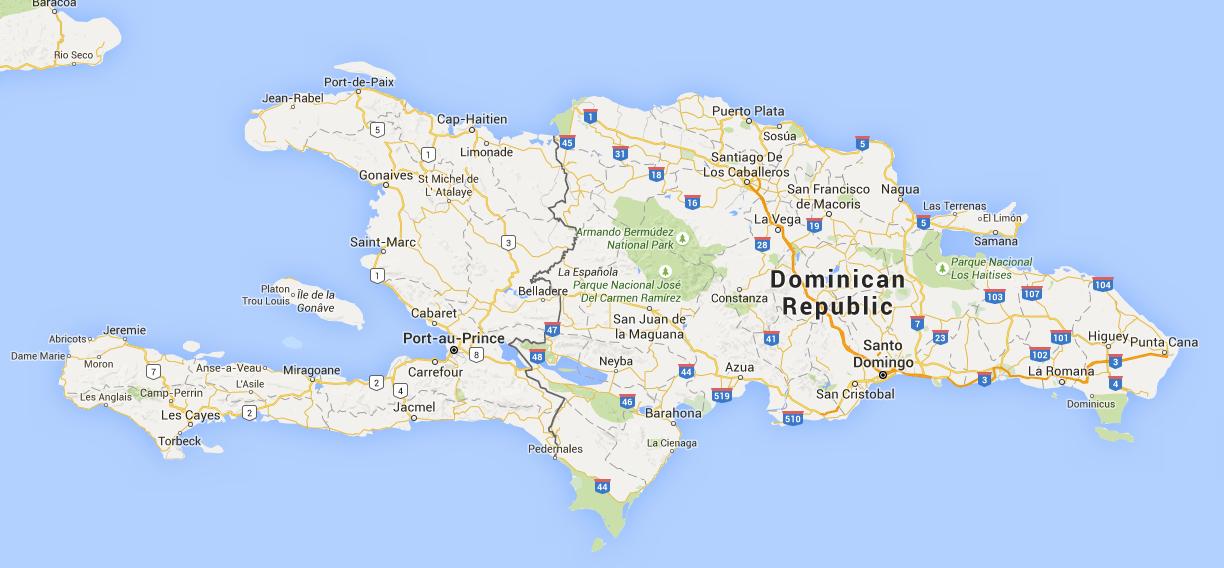
Map of Haiti and the Dominican Republic
From Google Maps
south coast of Haiti as Cape Esavois … Cape Haytien on the
north coast: Though Fields appears to have written
"Esavois," there is no such location in Haiti. It seems
likely that she actually meant something like Les
Irois, which names a small bay and town at the southwest
tip of Haiti, between Dame Marie and Les Anglais on the map
above. Cape
Haytien/Cap-Haďtien, on the north coast, is almost due
north of Port-au-Prince.
who do not go down to the sea in ships: See Psalm
107 in the Bible.
Lucayans ... Columbus: Wikipedia
says: "The Lucayans ...were the original inhabitants of
the Bahamas before the arrival of Europeans. They were a branch
of the Taínos who inhabited most of the Caribbean islands at the
time. The Lucayans were the first inhabitants of the Americas
encountered by Christopher Columbus. The Spanish started seizing
Lucayans as slaves within a few years of Columbus's arrival, and
they had all been removed from the Bahamas by 1520."
the Consul: Though the Consul is a Frenchman, with a daughter studying in France, it seems unlikely that they would request to see the French Consul. Presumably this person was the American Consul at Cape Haitien (Cap-Haďtien). When they arrive in Mayaguez, Puerto Rico, they meet an American Consul who's mother is French, suggesting that at this time American Consulates in the Caribbean Islands were at least sometimes headed by foreign nationals. Clarification on this topic and further information about this person and his family are welcome.
earthquake … 1848: The University of the West Indies Seismic Research Center documents an 1843 Caribbean Plate earthquake: "Considerable destruction in all islands from Saba to Dominica. Nearly 2,000 deaths, mainly in Guadeloupe. Considerable economic disruption in all islands." UWISRC provides a link to eyewitness accounts, placing the quake in February of 1843. However most sources say that the earthquake of 1840s that devastated Hispaniola took place on 7 May 1842.
Cuba is at present striking for home government: Wikipedia summarizes the history of Cuban independence activities in the middle 1890s:
An exiled dissident named José Martí founded the Cuban Revolutionary Party in New York in 1892. The aim of the party was to achieve Cuban independence from Spain. In January 1895 Martí traveled to Montecristi and Santo Domingo to join the efforts of Máximo Gómez.... Fighting against the Spanish army began in Cuba on 24 February 1895, but Martí was unable to reach Cuba until 11 April 1895. Martí was killed in the battle of Dos Rios on 19 May 1895. His death immortalized him as Cuba's national hero.
Around 200,000 Spanish troops outnumbered the much smaller rebel army, which relied mostly on guerrilla and sabotage tactics. The Spaniards began a campaign of suppression. General Valeriano Weyler, military governor of Cuba, herded the rural population into what he called reconcentrados, described by international observers as "fortified towns." These are often considered the prototype for 20th-century concentration camps. Between 200,000 and 400,000 Cuban civilians died from starvation and disease in the camps, numbers verified by the Red Cross and United States Senator Redfield Proctor, a former Secretary of War. American and European protests against Spanish conduct on the island followed.
The U.S. battleship Maine was sent to protect U.S. interests, but soon after arrival, she exploded in Havana harbor and sank quickly, killing nearly three quarters of her crew. The cause and responsibility for her sinking remained unclear after a board of inquiry. Popular opinion in the U.S., fueled by an active press, concluded that the Spanish were to blame and demanded action. Spain and the United States declared war on each other in late April 1898.
the Club room of Cape Haytien: I have been able to locate little information about the Club room of Cape Haytien, but it seems probable that Fields refers to the Union Club. Reuben Briggs Davenport, in "Hayti in War-Time" (or perhaps "In Hayti in War-Time") in Frank Leslie's Popular Monthly 48 (June 1899) pp. 187-204, presents quite a negative portrait of Haiti during the Spanish American War, confirming the fairly common belief among American political commentators that Haiti, in part because of its uncivilized Black population further degraded by the continuing influence of French culture, was incapable of self-government. This article refers to the Club at Cape Haytien: "The only modern establishments in Cape Haytien are the Club and the Savonnerie, the latter an industrial enterprise based partly on American and partly upon West Indian capital, which illustrates the rare possibility of making a financial success of concessions obtained from the jealous, narrow, and childish Port au Prince government" (p. 190).
Later in the piece, he presents a telling anecdote about the Club in Port au Prince:
News, or what passes for news, in Port au Prince is chiefly aired on the public streets, and in two or three principal cafes and bar-rooms. The local journalism is wholly ridiculous. The club, which, like that at Cape Haytien, is of mixed membership, is not largely frequented, but it is a good place in which to study the manners of the native ''gentleman." In most things he is imitative. In all that appears on a cursory examination, you see in him but a dark replica of the ordinary middle-class Frenchman of the provinces. The stamp of the oppressors of colonial Hayti remains distinct, indelible. This is a most curious phase of social evolution. Though the Haytians have so great a traditional hatred of the whites, they esteem anything that is French most highly. Nearly all their contracts for public works which cannot be filled in their own country go to France. On the metallic frames of public buildings, such as churches of recent date and the custom house and market sheds erected under Hyppolite [the current president], you may see the mark in raised letters of a Havre ironfounder. No doubt, if a fair opportunity were given them, American concerns could have furnished this material at a less cost than any in Europe.
The educated Haytian does not mind so much being swindled, provided it is done by the compatriots, perhaps even the descendants of his former masters. His manners in public are superficially excellent, but they have more than the Gallic insincerity. And the underlying barbarism crops out at odd moments. Once, at the Port au Prince club, a large, fine bat flew into the billiard-room and was caught just outside in the court-yard by the steward. A mulatto Haytian seized it and, with a hammer and some small nails, fastened it up on the outer wooden wall of the club house. Instinctively all the other Haytians of the place (it was about the middle of the afternoon) crowded about him and the victim. His eyes a-gleam with cruel expectancy, he hastened to relight his cigarette, and with the ardent end began to torture the bat, first blinding it and then applying the fire to its other very sensitive points. The poor creature squealed in agony, and the Haytians laughed and gloated over the entertainment. "It is fine fun!" cried one of them. My informant, an American, would have stopped their sport by means of a powerful muscular argument, but that he was a guest of the club, admitted by card, and bound to regard them as his hosts. He left the place at once in angry disgust and never set foot in it again. (p. 196)
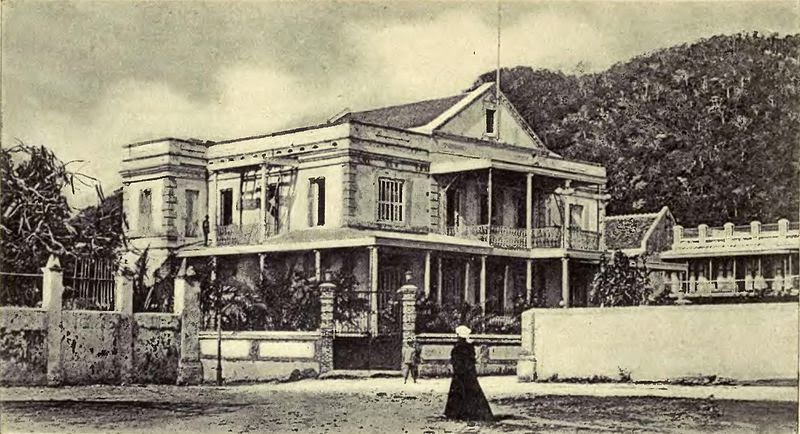
The Union Club at Cap-Haďtien
from Haiti, her history and her detractors
(1907) by Jacques Nicolas Léger, facing p. 78.
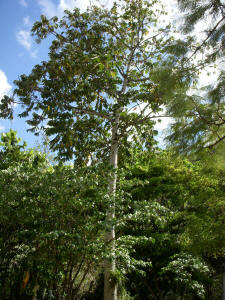 Panama Rubber Tree Image courtesy of Southwest Growers |
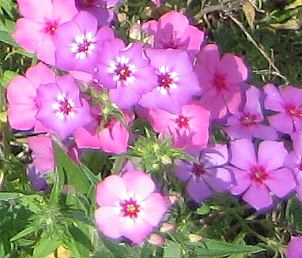 Drummond Phlox Courtesy of Wikipedia. |
coleas (crotons) ... a wild flower like a variegated and drummond flox {phlox}: It is unclear to what plant Fields may refer as numerous within either the garden or the club room itself. Did she see coleus or croton or something else? Phlox drummondii is native to the southern United States. Likewise, determining which phlox-like wild flower, with a cow, Fields may have observed from club room window is difficult without local help.
the Cathedral{,} the Bishop's home: The original Cathédrale Notre-Dame of Cap-Haďtien was built in 1784, then destroyed in the 1842 earthquake. In 1878, a new cathedral was completed, following the design of an American architect, according to Historic Architecture in the Caribbean Islands by Edward E. Crain (University Press of Florida, 1994, p. 209).
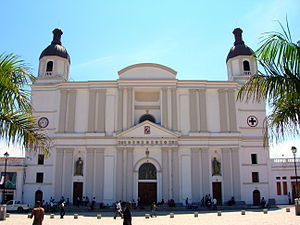
"Cathedral of Cap-Haitien" by Rémi Kaupp - Self-photographed. Licensed under CC BY-SA 3.0 via Commons
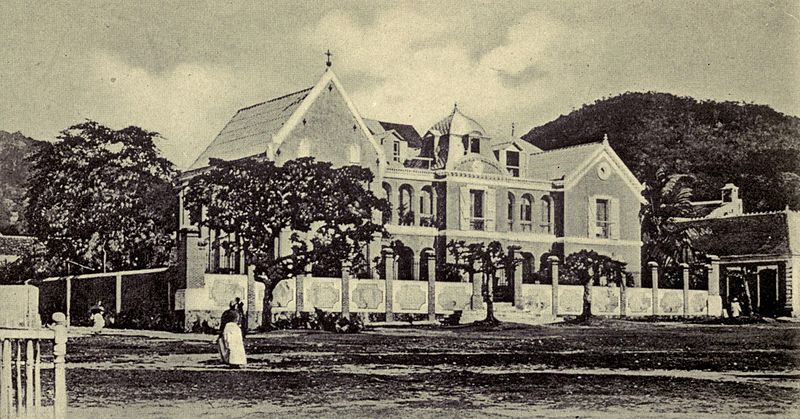
from Haiti, her history and her detractors
(1907) by Jacques Nicolas Léger, p. 270.
Edited by Terry Heller, Coe College.
The original of this diary is in the collection of the Massachusetts Historical Society. My copy is from a microfilm, available courtesy of the University of Kansas Libraries, Lawrence Kansas: Annie Adams Fields Papers 1852-1912. Folio PS 1669.F5 Z462 1986, Reel 2.
| Works of Annie Fields |